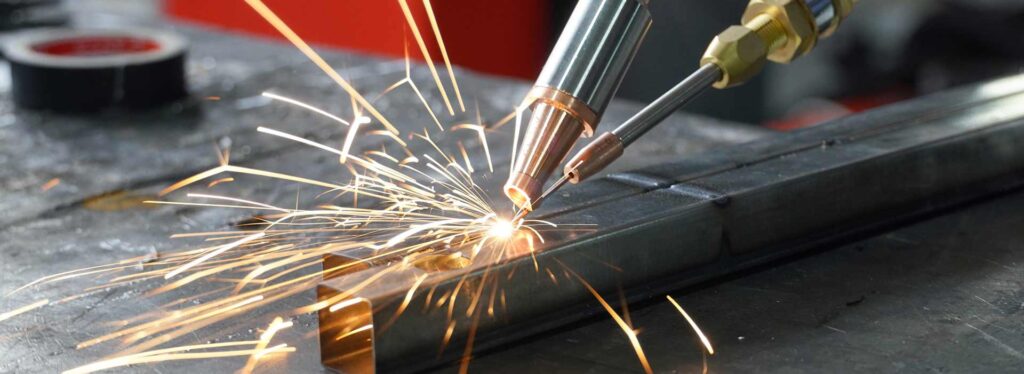Laser Technology Principle
Laser Generation and Characteristics
Laser is a highly coherent and monochromatic light beam generated by stimulated radiation. The generation mechanism of laser involves atoms or molecules jumping from a low energy level to a high energy level under the action of external energy (such as electric current, light or chemical reaction), and releasing photons when returning to the low energy level. These photons are reflected by the optical resonator and resonate with other atoms, eventually forming a high-intensity coherent light beam. Laser beams have unique characteristics such as monochromaticity, coherence and high directionality, which give them unique advantages in industrial cutting and processing. Monochromaticity ensures the energy concentration of the laser, coherence ensures the stability of the beam, and high directionality enables the laser to achieve high-precision energy control in cutting and processing.
Laser-Material Interaction
The interaction between laser and steel materials is mainly achieved through the photothermal effect. When a high-energy laser beam is irradiated on the surface of steel, its energy is absorbed by the material and converted into heat, causing the local temperature to rise rapidly, thereby triggering a series of physical and chemical changes. These changes include melting, vaporization and even plasma of the material, thereby achieving the effect of cutting or processing. Laser power density (P/A) is a key parameter affecting the cutting effect. The higher the power density, the faster the material’s absorption rate and heating rate.
Practical application analysis
Laser cutting technology is particularly widely used in the automotive and shipbuilding industries. In the automotive manufacturing field, cutting high-strength steel plates is a common application scenario. Laser cutting can accurately cut high-strength steel plates by controlling the power density and cutting speed, ensuring that their mechanical properties are not affected.
laser welding

Laser welding is a high-energy beam welding technology that uses the high energy density of laser to melt materials and achieve joints. Compared with traditional welding methods, laser welding has significant advantages in welding speed, weld quality and heat input. During the welding process, the energy of the laser beam is concentrated in a very small area, which can quickly heat the material and achieve deep penetration welding. Increasing laser power or reducing welding speed can increase penetration, thereby improving the strength and quality of welded joints. The high energy density of laser welding not only increases the welding speed, but also significantly reduces the scope of the heat-affected zone, reducing the thermal deformation and residual stress of the material. In addition, the laser welding process can be implemented in a highly automated environment and is suitable for mass production and precision welding of complex structural parts. Therefore, laser welding is widely used in automobile, aerospace, shipbuilding and other fields, especially in high-strength and high-precision welding of steel materials.
Laser surface treatment Laser surface treatment technology, including laser quenching and laser cladding, has important applications in improving the surface properties of steel materials. Laser quenching uses a laser beam to quickly heat the material surface to its phase transition temperature, and then quickly cools it through its own heat conduction to achieve surface hardening. Laser cladding uses a laser beam to melt the additive material and the base material to form a wear-resistant and corrosion-resistant surface layer. As the quenching depth increases, the surface hardness increases with the square root. This means that by controlling the laser power, scanning speed and focus position, the surface hardening effect can be precisely controlled to meet the needs of different application scenarios. Laser surface treatment technology has been widely used in machinery manufacturing, mold processing and metallurgical industries because it can significantly improve the surface properties of materials and extend their service life. It especially plays an important role in improving the wear resistance and corrosion resistance of steel materials.
Laser Additive Manufacturing
Laser additive manufacturing (AM), also known as 3D printing technology, is an advanced manufacturing method that manufactures complex parts by adding materials layer by layer. In the additive manufacturing of steel parts, the laser beam is used as a heat source to melt and solidify the metal powder layer by layer to form the desired shape. The laser energy density plays a key role in the formation and stability of the molten pool. A higher laser energy density can ensure the depth and width of the molten pool, and ensure the strength and uniformity of the interlayer bonding, thereby improving the mechanical properties of the additively manufactured parts. In the process of optimizing the process parameters, the laser power, scanning speed and spot diameter need to be precisely controlled to achieve the ideal molten pool morphology and metal microstructure.
Conclusión
In the field of steel cutting and processing, laser technology has significantly improved the quality and performance of the manufacturing process with its advantages of high precision, high efficiency and low heat-affected zone. Through the systematic application of laser cutting, welding and surface treatment technology, this technology not only solves the problems of unstable quality and severe thermal deformation existing in traditional processing methods, but also shows excellent performance in the additive manufacturing of complex parts. Through actual case analysis, the superiority of laser technology in optimizing process parameters, improving production efficiency and ensuring product quality has been fully verified. As the manufacturing industry continues to increase its demand for high-quality processing, laser technology will play an increasingly important role in the field of steel processing and promote the further development of the industry.

